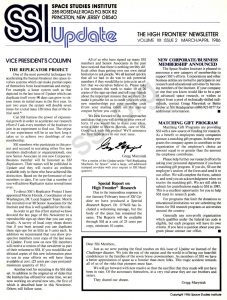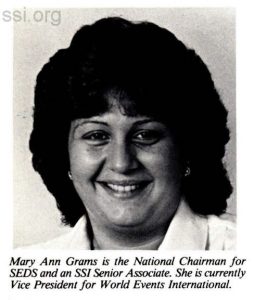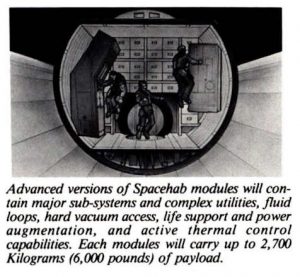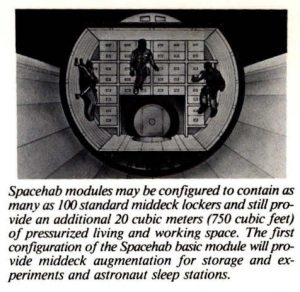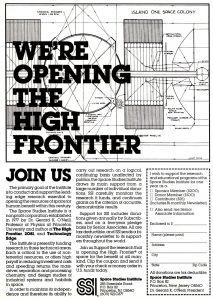SPACE STUDIES INSTITUTE
285 ROSEDALE ROAD, P.O. BOX 82
PRINCETON, NEW JERSEY 08540
[[librarian note: This address is here, as it was in the original printed newsletter, for historical reasons. It is no longer the physical address of SSI. For contributions, please see this page]]
SSI UPDATE
THE HIGH FRONTIER® NEWSLETTER
VOLUME XII ISSUE 2 MARCH/APRIL 1986
VICE PRESIDENT’S COLUMN
THE REPLICATOR PROJECT
One of the most powerful techniques for accelerating the human breakout into space involves systems which can make partial copies of themselves from local materials and energy. For example, a lunar system such as that depicted in the last issue of Update which can duplicate itself every 90 days can grow to sixteen times its initial mass in the first year. In just two years the system will double seven times for a total mass 128 times that of the initial seed.*
Can SSI harness the power of exponential growth in order to accelerate our research efforts? I ask every member of the Institute to join in an experiment to find out. The object of our experiment will be to see how long it takes us to achieve two doublings of our membership.
SSI members who participate in this project and succeed in recruiting either five new members (individual or organizational), one new Senior Associate or one new Corporate/ Business member will be honored as SSI Replicators. Their names will be published in Update and they will receive an emblem available only to those who have achieved this distinction. Based on the performance of our members to date, I’m sure that a number of you will achieve Replicator status several times over.
To direct SSI’s Replicator Project I have appointed Morris Hornik, Coordinator of our Washington, DC Local Support Team. Morris has recruited over 80 Senior Associates for the Institute and thus is well qualified for this role.
In order to get this effort started we have devoted the last page of this Newsletter to a reproducible sign-up sheet that you can copy locally. A survey of local copy shops shows that if you hunt around you can duplicate these sign-ups for as little as 3 cents each. In addition we recommend that you show prospective members your copy of the last issue of Update. From now on new SSI members will receive a version of that newsletter as part of their welcome to SSI. If you would like additional copies of this new information piece to use in your efforts we will have them available at cost. (25 cents per copy postpaid minimum quantity of 10.)
Another tool for recruiting is the SSI slide set. In addition to the original set of slides that the Institute has offered for some time, we are now working on several new sets, the first of which is described later in this Newsletter. Others will follow soon.
All of us who have signed up many SSI members and Senior Associates in the past have noticed that there is nothing terribly difficult other than getting over our own initial hesitation to ask people. We all learned quickly that all we had to do was to ask potential members if they would like to join us in an effort that we ourselves believe in. Please take a few minutes this week to make 10 or 20 copies of the sign-up sheet and tell your friends about the important mission that we share. To make it possible for us to credit you with your new memberships put your member code (from your mailing label) on the sign-up coupon before you copy it.
We look forward to the novel approaches and ideas that you will devise in your own efforts. If you would like to share your ideas, write a note to Morris Hornik, care of SSI. Good luck with this project! We’ll announce the first replicators in our next issue.
Gregg Maryniak
*For a reprint of the Update article “Self-Replicating Machines for Space” send a large, self-addressed stamped envelope with your request to SSI Headquarters.
Special Report on High Frontier® Research
Due to the tremendous response to our January/February issue of SSI Update we have produced a Special Research Report. Dr. O’Neill has included a welcoming message, but the body of the piece has remained the same. The Reports will be available through SSI at a cost of 25 cents per copy, mininum 10 copies.
————————————–
Dear SSI Members, Just as we were putting the final touches on this issue of Update we learned of the Challenger disaster. We join the rest of the nation and the world in offering our heartfelt condolences to the families of the seven brave crewmembers. As members of SSI we have a better appreciation of space as a frontier than most folks. This tragic accident reminds all of us of the risks that pioneers must face.
We will go forward with new resolve so that the sacrifice that they made will not have been in vain. Of the astronauts themselves, in a very real sense they are our brothers and sisters.
They shared our dream.
Gregg Maryniak
————————————–
NEW CORPORATE/BUSINESS MEMBERSHIP ANNOUNCED
The Space Studies Institute is pleased to announce a new category of membership to support SSI’s efforts. Corporations and other business entities are invited to participate in our research and educational activities by becoming members of the Institute. If your company or one that you know would like to be a part of advanced space research, or wishes to recruit from a pool of technically-skilled individuals, contact Gregg Maryniak or Bettie Greber at SSI Headquarters for additional information.
MATCHING GIFT PROGRAM
Matching Gift Programs are providing SSI with a new source of funding for research. As a benefit to employees many companies sponsor a matching gift program. In these programs the company agrees to contribute to the organization of the employee’s choice an amount equal to or greater than the amount the employee contributes.
Please help further our research efforts by asking your personnel department if you have a matching gift program. If you do, fill out the employee’s section of the form and send it to our office. We will complete the form, submit it, and send you an acknowledgment when we receive the matching gift. We are still able to submit for contributions made to SSI in 1985. This is a excellent opportunity for you to help SSI meet its research goals.
For programs that limit the donations to educational institutions we are submitting the forms for SSI research programs at universities around the country.
Generally any non-profit organization which qualifies under the federal tax code is eligible, but each program will have its own criteria. If you have a question about your program please contact our office.
STUDENTS WORKING TOWARDS THE HIGH FRONTIER
by Mary Ann Grams
Career-bound young people, tomorrow’s leaders and policy-makers, may become significant catalysts and actors in accomplishing the long-term goals of the Space Studies Institute. Because of this, it should come as no surprise that SSI is fostering a broader constituency for the High Frontier® concept among one of the most important and enthusiastic constituencies for this long-term development.
In one important example of this outreach to this constituency, the Students for the Exploration and Development of Space (SEDS) was invited to become the Student Auxiliary of the Space Studies Institute in 1984. Since that time, most of the Executive and Alumni Board of SEDS have become Senior Associates, and many of its members on college and high school campuses across the country are also involved. Much of the educational material produced by SEDS emphasizes this link, and SEDS’s leadership is intent on building upon our sound relationship.
Student participation in the space movement has grown enormously since the Students for the Exploration and Development of Space was started over five years ago on the Princeton and MIT University campuses. The group was founded out of a need for a greater role by the United States in space exploration and development. It is the emphasis on actually developing space TODAY that has attracted members of SEDS to work with and for the Institute.
Today, the founding Chairman of SEDS, Peter Diamandis, is the Boston-area Support Team Leader for SSI; Morris Hornik, formerly with the George Washington University SEDS Chapter, is the Washington, DC Support Team Leader; and other past and present officers are active SSI Senior Associates. Thousands of other SEDS members will be introduced to the High Frontier concept each semester through the activities of SEDS on campuses in the United States, Canada, and abroad.
Since 1980, SEDS members have watched the Shuttle Program grow to new heights in its operational phase and seen the promise of living and working in space in the 1990s on the proposed Space Station. Among the more popular chapter activities is making space Pilgrimages – sometimes as a Spring Break trip – to watch space Shuttle launches in Florida (with a possible lay-over in Ft. Lauderdale).
SEDS members volunteer to work at many significant space-related conferences, including the 1983 and 1985 Space Manufacturing Conferences held by SSI at Princeton. SEDS members have volunteered their time with several SSI Projects, including volunteer work on Mass-Driver III. It is true that many SEDS members are academically involved in space-related research and study, yet a great many others are non-science/liberal arts majors (in fact, my background is in Journalism and Political Science).
My father once told me that education is a lifelong process. That certainly applies to an organization like SEDS. SEDS continues to reach high school and college students to educate and guide them towards a further understanding of outer space, its applications here on Earth and its impact on life in the 21st century. A vision of an optimistic future for mankind offered by space exploration and development is a concept that most SEDS members share. Although some students may have space career interests, this is not at all a requirement.
The high school and college student of 1986 has spent an entire lifetime in the space age. SEDS members in high schools and universities today will be at the peak of their careers in the 2020s, and through their introduction to the High Frontier concept through SEDS and SSI activities, they may have the opportunity to see the dream of REAL space development take place as a result of their personal efforts. You can play a role in spreading the vision and the impact of today’s research – of the High Frontier invite you to help create SEDS Chapters at your nearby high school or university, or to serve as an advisor to an existing Chapter.
Young people of today are looking for opportunities in their future. SSI-related activities bring an important message of space development to them during their high school and university years, and this may require only a few moments of your time. Supporters of SEDS realize that space education during the career formation years is an extremely important and vital task if we are to ensure certain standards of living through a meaningful presence in space in our future. I hope you will join us!
For more information on SEDS, write: SEDS Headquarters, 800 21st Street NW, Suite 423, Washington DC 20052.
LOCAL SUPPORT TEAM ACTIVITIES
This month we have some special thankyous and announcements regarding local support efforts. First of all our special thanks to Minnesota Local Support Team Coordinator Scott Shjefte. Scott and the Minnesota L-5 Society have pledged $1000.00 in support of the Institute’s External Tank research and have already fulfilled half of the pledge.
Also from the Minneapolis area Senior Associates Jonathan Kolber and Steve and Linda Vetter donated a Sperry PC and an IOMEGA Bernoulli Box to the Institute. These pieces of equipment will help improve service to all members of the Institute and are greatly appreciated. In addition to the Vetters’ generous computer gift, they also made an important donation in support of SSI’s Breakthrough Projects. The Vetters were among the first members of SSI and they recently introduced Jon to the Institute. Jon has been active in promoting SSI activity in Minneapolis.
Dan McHugh, SSI’s New York City Coordinator, has agreed to become SSI’s liason to the American Institute of Aeronautics and Astronautics. Our new Manhattan coordinator is Senior Associate Rick Tumlinson. Rick has already arranged for the Local Support Team to meet regularly at the Air and Space Museum aboard the aircraft carrier Intrepid permanently docked in New York’s Hudson River. In addition, the New York local support team is working on a permanent SSI exhibit at the Intrepid. Anyone interested in assisting this program can write to Rick in care of SSI headquarters.
Also in the New York metropolitan area, Senior Associate Mike Massamino has agreed to become the coordinator of our newest local support team on Long Island. Special thanks are also in order to Senior Associates David Brody and Lingard Knutson who have helped get this effort started.
Finally, special thanks to Bill Mutschler of Custom Slides in Plainsboro, New Jersey who created an excellent set of custom slides for Gregg Maryniak’s presentation before the National Commission on Space.
NEW MASS-DRIVER SLIDE SET ANNOUNCED
The SSI staff is pleased to announce the availability of a new set of slides depicting the history of the Institute’s mass-driver research. The set includes rare slides of the first mass-driver under construction and set up for public demonstration at Princeton University. Mass-Driver II is shown in various stages of construction at Princeton and as it appeared during its test firings here. Several slides of Mass-Driver III, the most recent version with full lunar caliber, are also included.
In addition to the photographs of SSI’s experimental mass-drivers, the set includes an artist’s conception of a lunar base with a lunar mine, solar farm, habitats, workshops and the lunar mass-driver under construction. The final slide, prepared for SSI’s briefing to the National Commission on Space in December, summarizes the progress made by the Institute in mass-driver design and construction.
The slide set comes with an introduction and a complete set of descriptions of each image. The cost ofeach set is $15.00 postpaid. This set will make an ideal addition to your SSI collection.
SPACEHAB
Spacehab, Inc., a Seattle, Washingtonbased company that is developing pressurized middeck augmentation modules to fit in the Space Shuttle payload bay, announced today that it has signed a Memorandum of Understanding with NASA. The Spacehab modules will nearly double the available pressurized space aboard the Shuttle for crew accommodation, storage, and research by commercial and government customers.
In announcing the signing of the Memorandum of Understanding with NASA, Bob Citron, president of Spacehab, Inc., said that the company has been working with NASA Johnson Space Center Shuttle engineering divisions for over a year and has been engaged in negotiations with NASA headquarters on the “Memorandum of Understanding” since last August. The agreement, and a proposed “Modified Launch Services Agreement”, which Spacehab, Inc. plans to negotiate with NASA in 1986, could lead to the first Spacehab module flight aboard the Space Shuttle in early 1988. Spacehab, Inc. plans three to five module flights each year during the late 1980s and a number of additional flights each year beginning in the early 1990s.
“Spacehab has completed conceptual design studies with two major American and two major European aerospace companies that prove the feasibility of the concept and has completed preliminary market assessments that indicate a significant customer base for the use of the Spacehab modules,” Citron said. “The company plans to select an American prime contractor to supervise the design, construction, and testing of the Spacehab modules within the next few months.”
Aeritalia of Turin, Italy, builder of the primary structure and thermal and environmental control systems for the Space Shuttle Spacehab modules, has agreed to participate in the project as a European partner and will be involved in the design, construction, and testing of the Spacehab modules, according to Citron. MMB-ERNO of Bremen, Federal Republic of Germany, prime contractor for the European Space Agency (ESA) Spacelab system, and a participant in the Spacehab conceptual design studies, is currently negotiating with Spacehab, Inc. for participation in the Spacehab module project.
Spacehab aerospace engineers have been working on the orbiter middeck augmentation module concept for more than two years and, with the assistance of NASA Johnson Space Center engineering divisions, have developed a unique pressurized module system that will alleviate the significant backlog of Space Shuttle middeck experiments and open up the mantended micro-gravity environment to commercial and government space experimenters and entrepreneurs.
The Spacehab modules are truncated metal cylinders, 10 ft. long and 13 ft. in diameter, connected to the orbiter crew compartment airlock by standard NASA Spacelab tunnel adapters. Spacehab, Inc. plans to build three modules to enhance the operational capabilities of the Space Transportation System by providing over 1,000 cu. ft. of additional living and working volume and up to 100 middeck lockers for crew and orbiter stowage and man-tended experiments. Spacehab modules will increase existing orbiter crew compartment habitation volume by approximately 50 percent.
Prospective Spacehab users include NASA, the Department of Defense, companies developing space products, universities, research institutions, foreign governments and entrepreneurs requiring cost-effective and regular access to a man-tended micro-gravity environment in space. Demand for middeck volume for equipment storage, crew accommodation, testbed functions and research is expected to increase sharply by all of these groups during the next several years. Spacehab modules will provide a solution to the growing shortage of pressurized volume aboard the orbiters.
Advanced versions of Spacehab modules are planned for use as testbeds to test Space Station equipment and to provide additional astronaut living and working space for payload specialists, Space Station construction crews and other personnel. Future Spacehab modules may be used for Space Station logistics and operations support. They will also offer commercial users an opportunity for research and development of proprietary processes and the development of prototype production facilities in a simulated Space Station environment prior to making permanent commitments to Space Station facilities.
Spacehab, Inc. is a privately financed commercial space company that was founded two years ago by The Center for Space Policy, Inc. of Cambridge, Massachusetts and the Space Development Corporation of Seattle, Washington. For more information contact: Wendy Skony, Spacehab, Inc., Suite 510, 1107 NE 45th Street, Seattle, Washington, 98105.
©space studies institute

